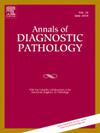The role of fine needle aspiration cytology in the diagnosis of mediastinal lesions: A 9-year experience from coastal Karnataka
IF 1.4
4区 医学
Q3 PATHOLOGY
引用次数: 0
Abstract
Fine needle aspiration cytology has emerged as a minimally invasive, cost-effective diagnostic tool with significant utility in evaluating mediastinal lesions. However, comprehensive data on its diagnostic accuracy, efficacy, and clinical impact on managing these lesions remain limited. This study aims to evaluate the diagnostic utility of fine needle aspiration cytology in mediastinal lesions, focusing on its accuracy, safety, and role in guiding therapeutic approaches. A cross-sectional retrospective analysis was conducted on patients who underwent fine needle aspiration for mediastinal lesions at our tertiary care centre between 2015 and 2024. Demographic data, cytological findings, histopathological correlation, and ancillary studies were reviewed. Diagnostic accuracy was assessed by comparing fine needle aspiration cytology findings with histopathological diagnoses. A cumulative total of 60 cases of mediastinal lesions were evaluated, of which 47 cases were considered suitable for cytological assessment. Among the 60 cases, 41 cases were identified as neoplastic (68.33 %), while 6 were classified as nonneoplastic (10 %) on cytology. Within the spectrum of neoplastic mediastinal lesions, lymphoma was recognised as the principal neoplastic entity, followed by thymic neoplasms and metastatic lesions. The overall diagnostic accuracy achieved through fine needle aspiration cytology in distinguishing these lesions was established at 83.8 %, with diagnostic accuracy being exceptionally high in metastatic lesions. Fine needle aspiration cytology of mediastinal lesions is a highly accurate, safe, and valuable diagnostic tool that significantly influences clinical management and treatment protocols. However, further studies with larger sample sizes and prospective designs are warranted to validate these results and refine procedural protocols.
细针抽吸细胞学在纵隔病变诊断中的作用:卡纳塔克邦沿海地区9年的经验
细针抽吸细胞学已成为一种微创、经济有效的诊断工具,在评估纵隔病变方面具有重要的实用价值。然而,关于其诊断准确性、疗效和治疗这些病变的临床影响的综合数据仍然有限。本研究旨在评估细针抽吸细胞学在纵隔病变诊断中的应用,重点关注其准确性、安全性以及在指导治疗方法中的作用。对2015年至2024年在我院三级保健中心接受纵隔病灶细针抽吸的患者进行横断面回顾性分析。回顾了人口统计学资料、细胞学发现、组织病理学相关性和辅助研究。通过比较细针穿刺细胞学结果与组织病理学诊断来评估诊断的准确性。共对60例纵隔病变进行了评估,其中47例认为适合细胞学评估。60例中,细胞学诊断为肿瘤41例(68.33%),非肿瘤6例(10%)。在纵隔肿瘤的范围内,淋巴瘤被认为是主要的肿瘤实体,其次是胸腺肿瘤和转移性病变。通过细针穿刺细胞学鉴别这些病变的总体诊断准确率为83.8%,在转移性病变中诊断准确率特别高。纵隔病变的细针抽吸细胞学是一种高度准确、安全、有价值的诊断工具,对临床管理和治疗方案有重要影响。然而,需要更大样本量和前瞻性设计的进一步研究来验证这些结果并完善程序协议。
本文章由计算机程序翻译,如有差异,请以英文原文为准。
求助全文
约1分钟内获得全文
求助全文
来源期刊
CiteScore
3.90
自引率
5.00%
发文量
149
审稿时长
26 days
期刊介绍:
A peer-reviewed journal devoted to the publication of articles dealing with traditional morphologic studies using standard diagnostic techniques and stressing clinicopathological correlations and scientific observation of relevance to the daily practice of pathology. Special features include pathologic-radiologic correlations and pathologic-cytologic correlations.

 求助内容:
求助内容: 应助结果提醒方式:
应助结果提醒方式:


